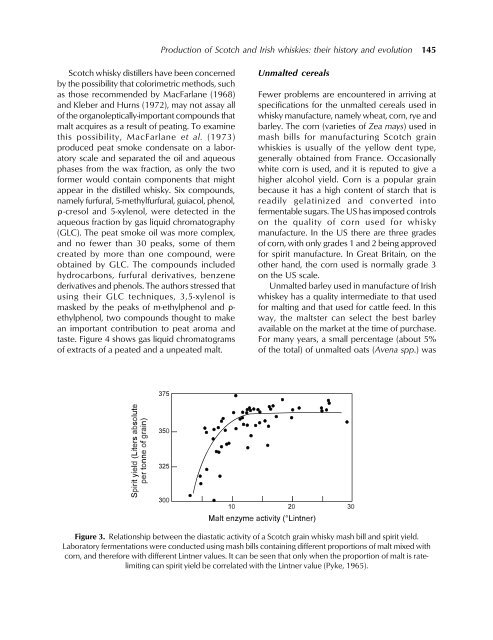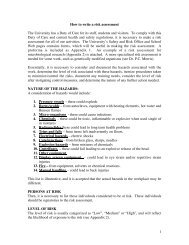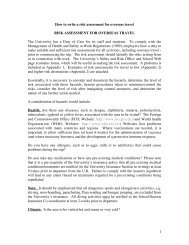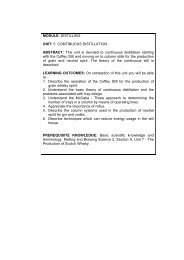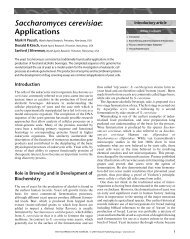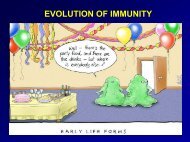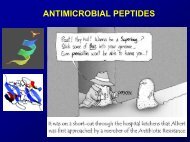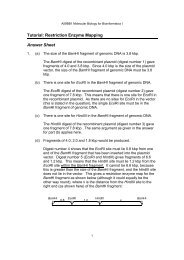144 T.P. Lyonssuitably low moisture level for storage, curing togive it the appropriate flavor <strong>and</strong> retainingsufficient enzyme activity (Simpson, 1968). Inmaltings attached to the distillery, the kilntemperature is increased slowly over a 48 hrperiod to achieve an even rate <strong>of</strong> drying <strong>and</strong> thedesired flavor. The latter character is achievedby fuelling the furnace with peat during the earlypart <strong>of</strong> the kilning period when the green malt ismoist <strong>and</strong> readily absorbs the peat smoke or‘reek’. In mechanical maltings the green malt isdried at a faster rate with a forced-air draught,but a supplementary peat-fired kiln is <strong>of</strong>ten usedto produce flavored malts. The amount <strong>of</strong> peatused varies with different maltings. Some <strong>of</strong> thedistilleries on Islay in Scotl<strong>and</strong> specialize inproducing a whisky with a very pronounced peatflavor, <strong>and</strong> they therefore use heavily-peatedmalts. Malted barleys used in the manufacture<strong>of</strong> <strong>Scotch</strong> grain <strong>and</strong> <strong>Irish</strong> <strong>whiskies</strong> are not driedover a peat fire. They generally have a greaterenzyme activity, so the relatively small proportion<strong>of</strong> malted barley used in the mash containssufficient enzyme activity to convert all <strong>of</strong> thestarch in the mash (principally supplied byunmalted cereals) into fermentable sugars. Thegreater enzyme activity in these malted barleysis reflected in <strong>their</strong> nitrogen content. Malts usedin production <strong>of</strong> <strong>Scotch</strong> grain whisky have anitrogen content <strong>of</strong> 1.8% or higher (comparedwith a brewer’s malted barley with a nitrogencontent in the region <strong>of</strong> 1.5%) (Hough et al.,1971). Malting aids, such as gibberellic acid <strong>and</strong>bromate, are not normally used in production<strong>of</strong> malted barley for whisky manufacture.Because <strong>of</strong> the high cost <strong>of</strong> malted cereals,considerable effort has been expended by thewhisky distiller in attempting to devise methodsthat allow prediction <strong>of</strong> the yield <strong>of</strong> alcoholexpected using different proportions <strong>of</strong> maltedbarley in the mash bill. Unfortunately, the methodscustomarily used by the brewer, such as thoserecommended in Great Britain by the Institute<strong>of</strong> Brewing Analysis Committee (1975), haveproved <strong>of</strong> limited value. The brewer has usedmeasurements <strong>of</strong> diastatic power, expressed asthe Lintner value, which is a measure <strong>of</strong> theextent <strong>of</strong> saccharification <strong>of</strong> soluble starchpresent in a cold water extract <strong>of</strong> the malt (LloydHind, 1948) as an indicator <strong>of</strong> malt quality.Diastatic activity measured in this way includescontributions from both "- <strong>and</strong> ß-amylases.However, Preece <strong>and</strong> his colleague (Preece,1947; 1948; Preece <strong>and</strong> Shadaksharaswamy,1949 a,b,c) have shown that high ß-amylaseactivity, as determined by the Lintner value, isnot always accompanied by high "-amylaseactivity. Pyke (1965) showed that the Lintnervalue <strong>of</strong> a malt is only useful for predicting thespirit yield in manufacture <strong>of</strong> <strong>Scotch</strong> grain whiskywhen the proportion <strong>of</strong> malted barley in themashbill is low (Figure 3). Determination <strong>of</strong> "-amylase activities <strong>of</strong> the malt gave a lesssatisfactory correlation than the Lintner value, anobservation which agrees with that made earlierby Thorne et al. (1945). Further evidence for theunsuitability <strong>of</strong> employing traditional maltspecifications for predicting performance inwhisky manufacture has come from Griffin(1972).Although the degree to which a malted barleyhas been peated can to some extent be assessedby smell, such is the importance <strong>of</strong> this characterin malt that it must be determined in a morerigorous fashion. Peat smoke or ‘reek’ containsa wide range <strong>of</strong> compounds, but it is generallyheld that the peaty character is imparted to themalt largely as a result <strong>of</strong> absorption <strong>of</strong> phenols.For some years, <strong>Scotch</strong> distillers used a methodbased on a reaction <strong>of</strong> phenols with diazotizedsulphanilic acid. A lack <strong>of</strong> specificity in thismethod, coupled with the instability <strong>of</strong> thediazonium salt, prompted MacFarlane (1968) torecommend an alternative method involvingextraction <strong>of</strong> phenols from malt with diethyletherunder acid conditions with absorptiometricmeasurement <strong>of</strong> the color developed when thephenols are reacted with 4-aminophenazone.MacFarlane applied the method to a wide variety<strong>of</strong> malts, both peated <strong>and</strong> unpeated, <strong>and</strong>reported values ranging from zero (for anunpeated grain) to as high as 9.4 ppm for a maltproduced on Islay in Scotl<strong>and</strong>. (It has beencalculated that to obtain a malt with 10 ppmphenols, one tonne <strong>of</strong> peat must be used fordrying each tonne <strong>of</strong> malted barley).
<strong>Production</strong> <strong>of</strong> <strong>Scotch</strong> <strong>and</strong> <strong>Irish</strong> <strong>whiskies</strong>: <strong>their</strong> <strong>history</strong> <strong>and</strong> evolution 145<strong>Scotch</strong> whisky distillers have been concernedby the possibility that colorimetric methods, suchas those recommended by MacFarlane (1968)<strong>and</strong> Kleber <strong>and</strong> Hurns (1972), may not assay all<strong>of</strong> the organoleptically-important compounds thatmalt acquires as a result <strong>of</strong> peating. To examinethis possibility, MacFarlane et al. (1973)produced peat smoke condensate on a laboratoryscale <strong>and</strong> separated the oil <strong>and</strong> aqueousphases from the wax fraction, as only the tw<strong>of</strong>ormer would contain components that mightappear in the distilled whisky. Six compounds,namely furfural, 5-methylfurfural, guiacol, phenol,D-cresol <strong>and</strong> 5-xylenol, were detected in theaqueous fraction by gas liquid chromatography(GLC). The peat smoke oil was more complex,<strong>and</strong> no fewer than 30 peaks, some <strong>of</strong> themcreated by more than one compound, wereobtained by GLC. The compounds includedhydrocarbons, furfural derivatives, benzenederivatives <strong>and</strong> phenols. The authors stressed thatusing <strong>their</strong> GLC techniques, 3,5-xylenol ismasked by the peaks <strong>of</strong> m-ethylphenol <strong>and</strong> D-ethylphenol, two compounds thought to makean important contribution to peat aroma <strong>and</strong>taste. Figure 4 shows gas liquid chromatograms<strong>of</strong> extracts <strong>of</strong> a peated <strong>and</strong> a unpeated malt.Unmalted cerealsFewer problems are encountered in arriving atspecifications for the unmalted cereals used inwhisky manufacture, namely wheat, corn, rye <strong>and</strong>barley. The corn (varieties <strong>of</strong> Zea mays) used inmash bills for manufacturing <strong>Scotch</strong> grain<strong>whiskies</strong> is usually <strong>of</strong> the yellow dent type,generally obtained from France. Occasionallywhite corn is used, <strong>and</strong> it is reputed to give ahigher alcohol yield. Corn is a popular grainbecause it has a high content <strong>of</strong> starch that isreadily gelatinized <strong>and</strong> converted int<strong>of</strong>ermentable sugars. The US has imposed controlson the quality <strong>of</strong> corn used for whiskymanufacture. In the US there are three grades<strong>of</strong> corn, with only grades 1 <strong>and</strong> 2 being approvedfor spirit manufacture. In Great Britain, on theother h<strong>and</strong>, the corn used is normally grade 3on the US scale.Unmalted barley used in manufacture <strong>of</strong> <strong>Irish</strong>whiskey has a quality intermediate to that usedfor malting <strong>and</strong> that used for cattle feed. In thisway, the maltster can select the best barleyavailable on the market at the time <strong>of</strong> purchase.For many years, a small percentage (about 5%<strong>of</strong> the total) <strong>of</strong> unmalted oats (Avena spp.) wasFigure 3. Relationship between the diastatic activity <strong>of</strong> a <strong>Scotch</strong> grain whisky mash bill <strong>and</strong> spirit yield.Laboratory fermentations were conducted using mash bills containing different proportions <strong>of</strong> malt mixed withcorn, <strong>and</strong> therefore with different Lintner values. It can be seen that only when the proportion <strong>of</strong> malt is ratelimitingcan spirit yield be correlated with the Lintner value (Pyke, 1965).


